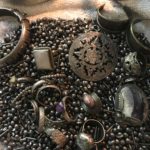I think it’s safe to say that most of us love our tumblers. They save us countless hours of hand polishing as well as beautifully work-hardening the creations that we have laboured over. I must confess that when I first heard about putting my finished ring (before setting the stones!!) in the tumbler with all that steel shot, I thought that was the most insane thing I’d heard! But lo and behold, it came out looking better than I could ever have imagined. Now I use the tumbler all the time to finish pieces for a professional look. So, like any other tool that you have, show your tumbler some love by taking care of it. This means that you may need to decontaminate it sometimes if your jewellery is not coming out bright and shiny.
New Tumbler Barrels: So, let’s say you are in the market for a new rotary tumbler. Rubber tumbler barrels are made from a man-made rubber called SBR ( Styrene Butadiene) which is composed of different substances found all over the world, and can vary greatly in quality. Generally, American brands, such as LORTONE, are made from higher quality materials.

Inexpensive Chinese tumblers are quite often used for rock tumbling and can be made from substandard materials that break down more easily. If you are buying a tumbler in person, take a piece of white paper with you and wipe it on the inside of the barrel. If the white paper shows black residue, it means the barrel is already starting to degrade. When you get your new tumbler and steel shot home, put the shot in the tumbler drum and run it in a 50/50 solution of water and vinegar for three 20 minute cycles and then a 20 minute rinse cycle with water and about two tablespoons of baking soda. This will clean the shot and drum of any grease or residue that may be present from the manufacturer. A quick note about steel shot: Carbon steel works just as well as stainless steel shot, but you must make sure the shot is kept in the barrel, covered with soapy (Ivory bar soap) water. After shaving in the soap and securing the lid, give the barrel a good shake! This will keep your carbon steel shot from rusting!! Check out more info about this HERE. If you take proper care of your steel shot, no matter what kind, it will last you a lifetime, and that is good value for your money.
Proper Usage: When using your tumbler, the less expensive ones are better off with just plain water with shaved Ivory bar soap. You can use burnishing compound, but dilute it to 50% of the manufacturer’s suggested strength as it can be quite caustic and can contribute to barrel breakdown. In the Workingsilver studio, we use plain water with a few shavings from a bar of Ivory soap, which works great! NEVER use detergent! We also use two pounds of shot in a three pound barrel for the best results in 30 minutes to two hours (with only 1 pound of shot in the barrel, you’ll be tumbling for 4-5 hours to get the same results). DO NOT USE ammonia, high alkaline solutions (borax), solvent based solutions (acetone, citrus cleaner), bleach, Liver of Sulfur, or mild chemicals in your tumbler barrel. These are all substances that will break down the rubber barrel and cause contamination. Change the soapy water in the barrel when it looks a bit grey (dirty). If you notice your pieces coming out with a yellow film or worse with black sludge on them, it’s time to decontaminate!

Decontamination: Believe it or not, many people use flat Coke as a cleaner in their tumbler barrel. Coke contains phosphoric acid which is a corrosive chemical used to remove rust from steel and iron. (Think about that next time you’re enjoying a cold glass of Coke!) The pH is very acidic, ranging from 2.8 to 4.5, which seems to strip the sludge very effectively from the barrel. Lemon juice and vinegar have a similar ph and could be tried especially if you don’t keep Coke around the house. CLR has a pH of 1 to 1.5 and has been used with success as well. We also use CLR to clean our carbon steel shot if there is any evidence of rust (orange water or the smell of rust). No matter which of these liquids you use, run the tumbler and shot for 3 twenty minute cycles – changing the liquid “cleaner” for each cycle until your shot is shiny and clean, then rinse well with clean water. Once your drum is decontaminated, use only mild soap (Ivory) when tumbling jewellery to prevent future contamination.
Unfortunately, this may not work for tumbler barrels of poor quality rubber, or ones that have been badly damaged. In that case, buy a new, good quality tumbler and follow the above instructions to ensure that it remains contaminant free.
A word about tumbling stones that are set in your jewellery pieces: The general rule is DO NOT TUMBLE STONES! Tumble your pieces prior to setting the stones. Stones that can be safely tumbled are Cubic Zirconia, which are in the 8.5-9 range on the Moh’s scale. When we set CZ in tubes in our jewellery pieces at Workingsilver, we tumble the finished pieces for up to 30 minutes (max) to ensure the stones are well set – and to give the pieces a final polish.
Tarnish: Sometimes your pieces may be coming out tarnished. This can happen for many reasons such as high alkalinity caused by too much soap or burnishing solution, dirty shot, new shot that has not been properly cleaned or even the pH of the water. If you are only using a little bit of soap or burnishing solution, rinse the barrel and shot and run them for twenty minutes with plain water and two tablespoons of baking soda. Then run with plain water and a piece of silver for one hour. If it’s still tarnishing, change to distilled water. For tarnished pieces, a silver dip is the easiest way to remove the tarnish, as long as there are no stones that could be damaged by the silver dip. Also, make sure that your jewellery pieces are clean before you put them in the tumbler- tumbling is for polishing and work hardening, not cleaning !
I think that’s about it. Remember, take care of your tools and they will take care of you and your jewellery for many, many years!
Some of the information in this post is from the fine people at Cool Tools. Thanks for spreading the knowledge!
